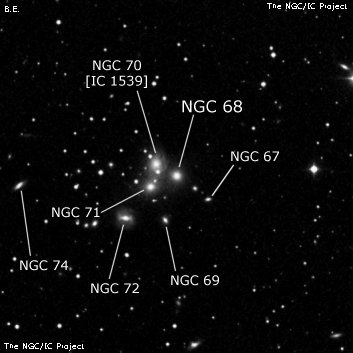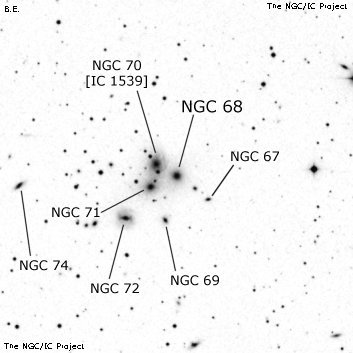NGC/IC Project Restoration Effort
(This is a very very beta version)
NGC68


Basic Information
Location and Magnitude
Right Ascension: 0:18:18.2
Declination: +30:4:21
Constellation: AND
Visual Magnitude: 12.9
Historic Information
Discoverer: Herschel W.
Year of discovery: 1784
Discovery aperture: 18.7
Observational
Summary description: eF, L, 3 or 4 st + neb
Sub-type: E-S0
Corwin's Notes
=====
NGC 68 is the brightest galaxy in a compact group. WH listed one of his fifth
class ("large") nebulae here, so I think it likely that he saw the merged
light of at least NGC 68, 70, and 71, the three brightest in the group.
Several of the stars in the vicinity probably also added to the "object" that
WH catalogued.
LdR picked out seven of the nebulae here, and suspected at least two others.
His sketch shows the seven, along with several stars, two of which turn out to
be galaxies. See NGC 67, IC 1538, and IC 1539 for more on this group.
Steve's Notes
=====
NGC 68
24" (9/15/12): at 322x appeared fairly faint to moderately bright, fairly small, round, 25" diameter, high surface brightness though contains a brighter nucleus. One of the brighter members in a dense group of galaxies and forms a tight trio with NGC 70 1.0' NE and NGC 71 1.3' SE. In addition, CGCG 499-104 is just 57" SW. In total, 10 galaxies were logged in a 5' circle!
18" (11/14/09): fairly faint, small, round, 25" diameter. Appears as a compact knot (like a core) of moderate surface brightness with no outer halo. Forms the southwest vertex of a tight trio with NGC 70 and NGC 71 in a dense group.
17.5" (8/27/87): faint, small, slightly elongated WNW-ESE, weak concentration. This galaxy is the brightest in a compact group and first in an interconnected trio with NGC 70 1.0' NE and NGC 71 1.2' SE. An extremely difficult galaxy, NGC 67, is just 0.9' SW.



